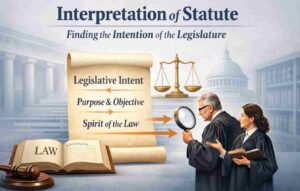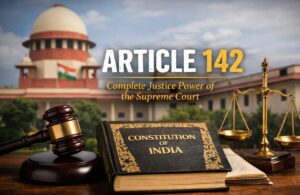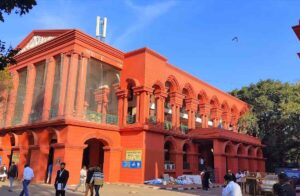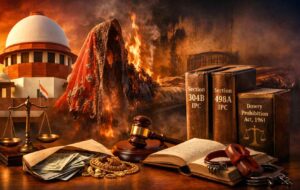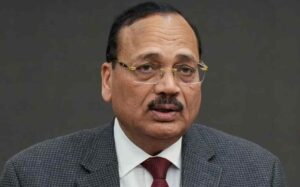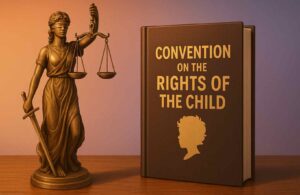Article 12 of the Indian Constitution defines “the State” for enforcing Fundamental Rights. It includes the government, legislatures, local bodies, and authorities under state control. Courts interpret it broadly to ensure accountability and protect citizens’ rights from arbitrary state actions.
The Constitution of India is a living document, a beacon of democratic values that enshrines the rights of citizens and delineates the duties of the state.
Among its many pivotal provisions, Article 12 plays a crucial role. This article defines “the State” as enforcing Fundamental Rights under Part III of the Constitution.
Over time, its interpretation has evolved through judicial pronouncements and scholarly debates, shaping how courts protect every citizen’s rights.
As legal scholar H.M. Seervai once remarked,
“The Constitution is not merely a legal document; it is a living testament to our democratic spirit.”
Fundamental rights are essential freedoms guaranteed to all Indian citizens under Part III of the Constitution.
These rights apply to everyone, regardless of race, birthplace, religion, caste, or gender. They are legally protected and cannot be infringed upon by the government.
However, they are primarily enforceable against the state and its authorities, not against private individuals or organizations. The government must uphold and safeguard these rights.
Most fundamental rights are claimed against the state and its entities rather than private bodies. Article 12 of the Constitution expands the definition of ‘state’ to determine which institutions fall under this category and are responsible for protecting these rights.
The Constitution’s framers intended for the term ‘state’ to have a broader meaning than just the individual states within the Union.
The use of the word ‘includes’ in Article 12 indicates that the definition is not limited, allowing courts to interpret it more broadly over time. Judicial rulings have expanded the scope of Article 12 far beyond what its drafters may have initially envisioned.
Purpose and Definition of ‘State’ in the Indian Constitution
The core objective of the Indian state, as envisioned by the Constitution, is to establish a welfare society.
Inspired by the idea of a welfare state, the framers of the Constitution aimed to create a system that ensures economic security and social justice for all citizens.
The concept of a welfare state, originally developed in Germany, revolves around the idea that the government should actively work to provide for the well-being of its people.
To achieve this, the Indian Constitution imposes both negative and positive duties on the state.
The negative duty is reflected in Fundamental Rights (Part III of the Constitution), which act as restrictions on the state to prevent arbitrary actions that could infringe on individual freedoms.
On the other hand, the positive duty is outlined in the Directive Principles of State Policy (Part IV), guiding the state to take proactive steps toward social and economic justice.
Why Define ‘State’?
Most Constitutions worldwide guarantee fundamental rights only against the state, meaning that citizens can seek legal remedies if their rights are violated by the government.
However, these rights may not always be enforceable against private individuals. Even in cases where the Constitution does not explicitly mention that rights apply solely against the state, courts have often interpreted them this way.
For instance, in the United States, fundamental rights are understood to be enforceable only against state actions, as noted by V.N. Shukla in his book Constitution of India.
A similar principle applies in India. This makes it crucial to define what constitutes a ‘state’ under the Constitution. Article 12 provides this definition, making it the foundation for interpreting fundamental rights in Part III.
Judicial Interpretation of ‘State’
The judiciary has played a key role in shaping how the term ‘state’ is understood. One of the earliest cases on this subject was P.D. Shamdasani v. Central Bank of India (1951).
In this case, a private bank sold the petitioner’s shares to recover a debt. The petitioner argued that this action violated his fundamental rights under Articles 19 and 31 (now omitted).
However, the Supreme Court ruled that fundamental rights could be enforced only against the state, not private entities.
If a private party violates someone’s rights, legal remedies must be sought under ordinary law, not under the Constitution.
However, in a more recent case, Kaushal Kishore v. State of U.P. (2023), the Supreme Court expanded this interpretation. It held that fundamental rights under Articles 19 and 21 can also be enforced against non-state actors in certain situations.
This marked a shift in constitutional jurisprudence, recognizing that rights violations can occur beyond direct state action.
Direct vs. Indirect Infringement of Rights
When discussing state responsibility, it’s important to understand the two ways in which fundamental rights can be violated:
- Direct Infringement – When the government itself takes actions that infringe on people’s rights, such as passing laws that suppress free speech or personal freedoms.
- Indirect Infringement – When government officials or agencies, acting on behalf of the state, violate citizens’ rights through their actions.
To safeguard citizens from arbitrary state action, courts have consistently interpreted the definition of ‘state’ in an inclusive manner.
Citizens’ Duties Toward the State
While the state has a duty to protect individual rights, citizens also have certain responsibilities. In 1976, the 42nd Amendment introduced Fundamental Duties into the Constitution under Article 51A. These duties include:
- Showing respect for the National Flag and National Anthem
- Upholding the sovereignty and integrity of India
- Preserving the country’s rich cultural heritage
Although these duties are not legally enforceable, they serve as moral obligations that promote responsible citizenship.
Historical Context and the Drafting of Article 12
When India’s Constituent Assembly set out to frame the nation’s constitution in the wake of colonial rule, one of the foremost tasks was to ensure that the new document would guarantee not only rights but also effective remedies against violations.
The framers—many of whom were influenced by democratic traditions across the globe—understood that the concept of “the State” needed a broad definition.
Article 12 was introduced to capture the full range of governmental entities against which citizens could seek redress if their Fundamental Rights were violated.
During the debates in the Constituent Assembly, figures such as Dr. B.R. Ambedkar argued passionately for an inclusive definition. He noted,
“To safeguard the rights of every individual, the term ‘State’ must extend beyond the obvious organs of government.”
Thus, Article 12 was designed to include not only the government at the central and state levels but also local bodies and other agencies carrying out public functions.
This was essential because Fundamental Rights are available against state action—and without a clear definition of “the State,” the entire chapter on Fundamental Rights would lack practical effect.
The framers were mindful that the ordinary meaning of the word “state” might be too narrow. Hence, they inserted a proviso—“unless the context otherwise requires”—to allow for flexibility in interpretation.
This foresight ensured that as the country’s administrative structure expanded over time, Article 12 would continue to provide a broad protective umbrella over citizens’ rights.
Meaning of “State” Under Article 12
Article 12 of the Indian Constitution lays down the definition of “State” for the purpose of Part III, which deals with fundamental rights. It states:
“Unless the context otherwise requires, the State includes the Government and Parliament of India, the Government and the Legislature of each of the States, and all local or other authorities within the territory of India or under the control of the Government of India.”
In simpler terms, the entities that fall under the definition of “State” include:
- The Union Government and Parliament (Executive & Legislature of the Centre)
- The State Governments and State Legislatures (Executive & Legislature of the respective States)
- Local Authorities within India’s territory
- Other Authorities under the control of the Indian Government
Key Concepts Under Article 12
To fully grasp the scope of “State,” it’s essential to break down certain critical terms mentioned in the article:
- Government (Union & State) – Refers to the ruling authority at both the central and state levels.
- Parliament & State Legislatures – The legislative bodies responsible for making laws at both the Union and State levels.
- Local Authorities – Municipalities, panchayats, and other bodies responsible for local governance.
- Other Authorities – Any organization or institution under government control that exercises public functions.
- Territory of India – The geographical extent within which these entities operate, including states, union territories, and any other regions under India’s sovereignty.
- Control of the Government of India – Authorities functioning under the supervision or influence of the Indian government.
The Text and Interpretation of Article 12
The complete text of Article 12 reads:
“In this Part, unless the context otherwise requires, the State includes the Government and Parliament of India and the Government and the Legislature of each of the States and all local or other authorities within the territory of India or under the control of the Government of India.”
At first glance, the language is simple. Yet, its seemingly straightforward wording belies the complexity of its interpretation. Each component of the definition has been subject to extensive judicial analysis:
Government and Parliament of India:
This includes the executive and legislative branches at the national level. The term “Government” here refers to the Union executive, which is responsible for implementing laws and policies.
Meanwhile, the “Parliament” encompasses both houses—the Lok Sabha and the Rajya Sabha—that enact legislation.
By expressly including these institutions, Article 12 makes it clear that any violation of Fundamental Rights by central government agencies is actionable in a court of law.
Government and Legislature of Each State:
Article 12 extends the definition of “the State” to the state level. Each state’s government and its respective legislative assembly (and, where applicable, legislative council) are included.
This ensures that citizens in every corner of India can seek judicial remedies if state-level actions infringe upon their rights.
All Local or Other Authorities:
Perhaps the most debated part of Article 12 is the inclusion of
“all local or other authorities within the territory of India or under the control of the Government of India.”
Unlike the clearly identifiable institutions mentioned earlier, this phrase has prompted questions about its scope.
Does it include every statutory body? What about quasi-governmental organizations? Over the years, courts have grappled with these issues—interpreting “other authorities” in a way that best protects the Fundamental Rights of citizens.
In early interpretations, some judges applied the principle of ejusdem generis—that general words following specific ones should be interpreted in light of those specifics.
However, later decisions rejected a narrow reading, instead embracing a broader approach. This ensures that any body performing a public or governmental function—and subject to state control—is brought within the ambit of Article 12.
What are Local Authorities under Article 12?
Before diving into the concept of local authorities, let’s first break down the term “authority” itself.
According to Webster’s Dictionary, authority refers to an individual or entity that exercises power to command.
When interpreted under Article 12, it signifies the ability to create laws, regulations, orders, or notifications that carry legal weight. It also encompasses the power to enforce these laws.
What is a Local Authority?
The General Clauses Act, 1897, under Section 3(31), defines a local authority as any municipal committee, district board, body of commissioners, or other governing entity legally empowered or entrusted by the government to manage municipal or local funds.
This broad definition includes various governing bodies such as:
- Local Governments – As per Entry 5 of List II in the Seventh Schedule, local governments consist of municipal corporations, district boards, improvement trusts, mining settlement authorities, and other institutions responsible for local governance and village administration.
- Village Panchayats – The case of Ajit Singh v. State of Punjab established that village panchayats are also recognized as local authorities.
How Do We Identify a Local Authority?
In Mohammad Yasin v. Town Area Committee, the Supreme Court laid down key criteria to determine whether an entity qualifies as a local authority.
The organization must:
- Have a distinct legal identity as a corporate body.
- Operate independently, rather than merely being a government extension.
- Function within a defined geographical area.
- Be, at least in part, directly or indirectly elected by local residents.
- Maintain a degree of autonomy, whether full or partial.
- Be entrusted with public welfare duties like education, health, water supply, town planning, markets, or transport services.
- Have the authority to generate revenue through taxes, fees, or charges to support its activities.
The Scope of ‘Other Authorities’ Under Article 12
The term ‘other authorities’ in Article 12 has always been a subject of debate, as it hasn’t been explicitly defined anywhere—not in the Constitution, not in the General Clauses Act of 1897, nor in any other Indian statute.
Due to this lack of clarity, courts have had to step in over time, interpreting it differently based on the specifics of each case.
In India, government functions aren’t always carried out directly by departments or officials. Sometimes, they’re handled by autonomous bodies, including corporations, companies, and statutory authorities.
But do these bodies fall under the definition of ‘State’ under Article 12? That’s the key question courts have grappled with.
One of the earliest interpretations came in University of Madras v. Shanta Bai, where the Madras High Court applied the principle of ‘ejusdem generis’—a legal doctrine that means “of the like nature.”
The court ruled that only those entities performing governmental or sovereign functions could be considered ‘other authorities.’ This essentially excluded unaided universities and other private bodies from the definition.
However, this restrictive interpretation didn’t last long. In Ujjammabai v. State of U.P., the Supreme Court took a different stance.
It rejected the ejusdem generis rule, stating that the various bodies listed under Article 12 do not share a common thread or belong to a single category. Since there’s no clear genus, the court held that ‘other authorities’ should not be confined to just sovereign functions.
A more definitive ruling came in Rajasthan Electricity Board v. Mohan Lal. The Supreme Court clarified that ‘other authorities’ include any statutory body created by the Constitution or a law, as long as it has been granted powers—regardless of whether these powers are governmental, commercial, or otherwise.
Essentially, the focus was not on the nature of the function but on whether the body was created by law and given authority under it.
Over time, this broader interpretation has shaped how courts decide whether an entity qualifies as a ‘State’ under Article 12, ensuring that even non-traditional governmental bodies can be held accountable under fundamental rights.
How to Identify an Instrumentality of the State?
In India’s constitutional framework, the term “State” encompasses not only the government and its legislative bodies but also various instrumentalities through which the state performs its functions.
This inclusive definition ensures that entities acting on behalf of the government are subject to constitutional obligations, thereby safeguarding fundamental rights.
Determining Instrumentality of the State
To ascertain whether an entity qualifies as an instrumentality or agency of the state, the Supreme Court has established several criteria:
- Financial Assistance: If the state provides substantial financial support to the entity, it may indicate that the entity is an instrumentality of the state.
- Control Over Management and Policies: Entities under significant state control, especially in their management and policy decisions, are likely to be considered instrumentalities of the state.
- Monopoly Status: If the entity holds a monopoly status conferred or protected by the state, it may be deemed an instrumentality of the state.
- Public Importance of Functions: Entities performing functions of public importance that are closely related to governmental functions are more likely to be considered instrumentalities of the state.
- Transfer of Government Department: If a government department has been transferred to a corporation, the corporation may be considered an instrumentality of the state.
Case Law Illustrations
- Ajay Hasia v. Khalid Mujib Sehravardi (1981): In this case, the Supreme Court provided a six-factor test to determine whether an entity is an instrumentality or agency of the state.
- R.D. Shetty v. International Airport Authority of India (1979): The Court laid down five tests to determine whether a body is an agency or instrumentality of the state, including financial resources, deep and pervasive state control, and whether the functions are governmental in essence.
To determine whether an entity is an agency or instrumentality of the state, several factors are taken into account:
- Share Capital and Financial Support: One of the first indicators is whether the state owns all or most of the share capital of the corporation. If it does, the entity can be considered an instrumentality of the state. Furthermore, the state does not always have to provide direct financial aid; indirect assistance such as tax exemptions may also play a role. The Sukhdev Singh v. Bhagatram (1975) case clarified that even indirect forms of financial support, like tax breaks, can be key in determining if an entity is considered state-controlled.
- State Control: The degree to which the state influences or controls the organization’s operations is another important factor. When the central or state governments exercise significant control, it points toward the entity being an agency of the state.
- Monopoly Power: If the government grants an entity a monopoly, preventing other companies from entering the market, this is a strong indication that the corporation functions as an arm of the state.
- Public Functions: Another critical element is the type of functions the corporation carries out. If the entity performs functions that are essentially public in nature, such as those typically associated with the state, it may be classified as an instrumentality of the government.
When looking at the Territory of India, as defined in Article 1(3) of the Constitution, it encompasses all the territories within India, including states, union territories, and any territories that may later be acquired.
This definition helps in understanding the scope of jurisdiction and authority for cases involving Article 12.
In the case of the Masthan Sahib v. Chief Commissioner, the court affirmed that when we refer to the “territory of India” in Article 12, it specifically refers to the area defined in Article 1(3) of the Constitution.
Furthermore, under Article 12, the government’s control over an entity does not need to be absolute. Instead, it requires that the government has some degree of oversight or authority over the entity’s functioning.
The presence of a statutory framework alone does not automatically make an entity a “State”. Non-statutory bodies can also be considered part of the state if they are financially supported by the government and the government exerts substantial control over them.
For instance, bodies like Delhi Transport Corporation, ONGC, and Electricity Boards are considered state entities due to their government funding and control.
However, NCERT is not considered a state agency as it does not receive substantial government funding, nor does the government exercise pervasive control over it.
The Ajay Hasia case laid down a more flexible approach, emphasizing that determining whether an entity qualifies as a state requires evaluating the cumulative factors of control.
The question is whether the entity is financially and administratively dominated by or under the control of the government. The extent of control must be significant and specific to the entity in question.
Role of Judiciary Under Article 12 of the Indian Constitution
Article 12 of the Indian Constitution does not specifically mention the judiciary, leaving room for a complex understanding of its role in the state’s actions.
This ambiguity allows judicial authorities to make decisions that could potentially conflict with individuals’ Fundamental Rights.
If the judiciary were considered part of the ‘State,’ its actions would be bound by the obligation to protect citizens’ fundamental rights. However, judicial decisions themselves cannot be challenged simply for violating these rights.
The distinction between the judicial and non-judicial functions of courts is crucial here. When courts are engaged in non-judicial tasks, such as administrative functions, they can be considered part of the ‘State.’
In such instances, their decisions could be challenged for violating Fundamental Rights. But when courts are performing their judicial functions—resolving disputes brought before them—they are not part of the ‘State,’ and their decisions cannot be questioned on the grounds of fundamental rights violations.
This principle was affirmed by the Supreme Court in the case of Naresh Shridhar Mirajkar v. State of Maharashtra (1967). The nine-judge bench concluded that a judicial decision, delivered by a competent authority in relation to a matter before it, cannot infringe upon a citizen’s fundamental rights.
The primary purpose of such decisions is to settle the dispute between the parties involved, not to infringe upon rights. As such, these judicial decisions cannot be challenged under Article 13.
However, the judiciary does hold the power to define the scope of Fundamental Rights. In doing so, courts might make interpretative mistakes, but these do not amount to violations of the rights themselves.
Instead of invoking writ jurisdiction against a judicial decision, the appropriate remedy is through review or appeal before a higher court.
For decisions made by the Supreme Court, affected parties can file a review petition or, in exceptional circumstances, a curative petition.
The Supreme Court reinforced this idea in Khoday Distilleries Limited v. Registrar General (1995), where it ruled that once the final decision is made, and even after a review petition has been considered, no further writ jurisdiction can be used to challenge that decision under Article 32.
It’s important to note that this non-challengeability only applies to judicial decisions. Administrative or quasi-judicial decisions, such as those made by tribunals, can be challenged if the authority exceeds its jurisdiction or fails to exercise it properly.
In such cases, writ jurisdiction can be invoked to address any violation of Fundamental Rights.
The exclusion of the judiciary from the definition of ‘State’ is in line with the structure of India’s legal system, where an integrated judicial structure allows for checks and balances.
Decisions made by one court can be contested in higher courts, ensuring there is no final, unchallenged authority and providing a remedy for those aggrieved by judicial actions.
State of West Bengal v. Committee for Protection of Democratic Rights (2010)
Facts:
In this case, the petitioner argued whether the judiciary can be treated as a “State” under Article 12 of the Constitution.
The issue arose in the context of the West Bengal Human Rights Commission (WBHRC), a body that claimed it had the power to issue directions related to fundamental rights violations.
The question was whether the judiciary falls within the scope of “State” under Article 12, making it amenable to judicial review.
Issue:
The central issue was whether the judiciary is included within the scope of “State” under Article 12, which has specific implications for judicial review of judicial decisions.
Judgment:
The Supreme Court in this case ruled that the judiciary, specifically the higher judiciary (the Supreme Court and High Courts), is not a part of the “State” within the meaning of Article 12.
The Court distinguished between the judiciary’s functions and the role of the executive or legislature in determining the scope of Article 12. The judgment emphasized that the judiciary must be free from external control to maintain its independence, so it cannot be considered a “State” under Article 12.
Supreme Court Employees Welfare Association v. Union of India (1989)
Facts:
The petitioners in this case were employees of the Supreme Court of India, and they approached the Court with a claim of being denied certain benefits under the Service Rules, alleging a violation of their fundamental rights. They contended that the Supreme Court itself, as an institution, should be treated as a “State” under Article 12.
Issue:
The issue raised was whether the Supreme Court of India, as an institution, could be treated as a “State” under Article 12 of the Constitution for the purpose of granting fundamental rights protections to its employees.
Judgment:
The Supreme Court rejected the petitioners’ contention, stating that the judiciary does not fall within the ambit of “State” under Article 12. The Court held that judicial independence was paramount, and the relationship between the state and the judiciary is different from that of the state and executive bodies. Therefore, the judiciary, as a constitutional body, was not an “instrumentality” or “agency” of the state for the purposes of Article 12.
All India Judges Association v. Union of India (1992)
Facts:
This case revolved around the demand for improved working conditions, pay, and other benefits for judicial officers. The petitioners sought recognition of judicial officers under the definition of “State” for the purposes of granting constitutional protections and benefits to judges.
Issue:
The issue was whether judicial officers of the lower courts could be considered a “State” under Article 12, thereby entitling them to fundamental rights protection.
Judgment:
In this case, the Supreme Court ruled that judicial officers, while part of the judiciary, are not part of the “State” under Article 12. The Court reiterated its earlier ruling that the judiciary is independent of the executive and legislative branches, and as such, it is not covered under the definition of “State.” However, the Court also emphasized the need to improve the working conditions and remuneration of judges to maintain judicial independence.
Judicial Officers Association v. Union of India (2002)
Facts:
This case involved the issue of the salary and allowances of judicial officers in the lower courts. The petitioners sought the recognition of the judiciary as part of the “State” under Article 12 to invoke constitutional remedies.
Issue:
The issue here was similar to previous cases: Whether the judiciary, specifically the judicial officers, could be considered as part of the “State” under Article 12.
Judgment:
The Supreme Court held that judicial officers were not part of the “State” under Article 12 and that the judiciary, as a whole, did not come under the purview of “State” as envisioned in Article 12. The Court further stressed that while judicial officers were entitled to better pay and benefits, they should not be considered part of the State in the sense intended by Article 12.
National Judicial Appointments Commission (NJAC) Case (2015)
Facts:
This landmark case, officially known as Supreme Court Advocates-on-Record Association v. Union of India (2015), dealt with the constitutionality of the National Judicial Appointments Commission (NJAC), which aimed to replace the collegium system for the appointment of judges. The petitioners challenged the NJAC Act, arguing that it would undermine the independence of the judiciary.
Issue:
One of the issues raised was whether the judiciary, in its function to appoint judges, falls within the concept of the “State” under Article 12 for the purposes of judicial review.
Judgment:
The Supreme Court, in its judgment, reiterated that the judiciary is independent and does not fall within the scope of “State” under Article 12, highlighting that judicial independence is a cornerstone of the Constitution. The Court struck down the NJAC Act as unconstitutional, ruling that it violated the basic structure of the Constitution. Although this case dealt primarily with judicial appointments, it further clarified that the judiciary, as an institution, is not to be considered as a “State” under Article 12.
Landmark Judgments on the Definition of ‘State’ under Article 12 of the Indian Constitution
Rajasthan Electricity Board v. Mohan Lal and Others (1967)
In the case of Rajasthan Electricity Board v. Mohan Lal, 14 permanent employees of the Rajasthan State Government were deputed to the Electricity Board. Eleven employees were promoted to the position of assistant engineers, but the first respondent was denied this promotion.
He contested the decision, claiming that it violated his fundamental rights under Article 14 of the Constitution. The High Court found the petition to be maintainable, and the case eventually reached the Supreme Court.
- Issue: The central issue was whether the Rajasthan Electricity Board, established under the Electricity Supply Act of 1948, could be considered a “State” under Article 12 of the Constitution.
- Contentions: The appellants argued that the Electricity Board was not part of the State or Union Government and that it was a separate legal entity established for commercial purposes. They contended that the Board should not be classified as a ‘state’ since it engaged in commercial activities.
- Judgment: The Supreme Court ruled in favor of the respondent, stating that the Electricity Board, being an instrumentality of the government, fell within the definition of ‘State’ under Article 12. Despite its commercial functions, the Board was empowered by law to carry out public duties like distributing power and making rules for controlling electricity undertakings. The Court also rejected the argument of ejusdem generis (which would limit the term ‘State’), holding that no distinct genus existed among the bodies listed in Article 12.
Sukhdev Singh v. Bhagatram (1975)
In Sukhdev Singh v. Bhagatram, the petitioner was dismissed from his job at a statutory corporation. He claimed that his removal violated his fundamental rights under Article 14.
- Issue: The question was whether statutory corporations like the Life Insurance Corporation (LIC), Oil and Natural Gas Corporation (ONGC), and Industrial Finance Corporation (IFC) could be considered as ‘State’ under Article 12.
- Judgment: By a majority of 4:1, the Court held that these corporations were indeed “State” under Article 12. They were found to be instrumentalities of the state due to their pervasive government control and their role in carrying out statutory functions. These corporations had the authority to make rules and played a significant part in fulfilling state objectives.
- Dissent: Justice Alagiriswami dissented, arguing that statutory corporations should not be classified as the State since they were not exercising sovereign functions and their rules were similar to those made by ordinary corporations.
Shiny George Ambat v. Union of India (2023)
The case of Shiny George Ambat v. Union of India involved the dismissal of the petitioner from his position as the Chief Finance Officer at IIM Kozhikode. He challenged the decision under Article 226, questioning whether IIM could be considered an instrumentality of the State.
- Issue: The Kerala High Court had to determine whether IIM Kozhikode was an instrumentality of the State, making the writ petition maintainable.
- Judgment: The Court ruled that IIM Kozhikode was not a State within the meaning of Article 12. The institution, while receiving some government aid, operated independently with its own revenues and was governed by its own internal management. The Court noted that while the government had some control, it was not pervasive enough to classify IIM Kozhikode as an instrumentality of the State. Therefore, the petition was dismissed.
Ajay Hasia v. Khalid Mujib (1980)
In this case, the petitioner was an applicant for admission to an engineering college run by a society registered under the Jammu and Kashmir Registration of Societies Act. He challenged the arbitrary nature of the interview process under Article 14.
- Issue: The issue was whether the society running the engineering college could be regarded as the “State” under Article 12.
- Judgment: The Supreme Court held that the society running the college was an instrumentality of the State, making it a ‘State’ under Article 12. The Court emphasized that the structure of the society did not matter; what was significant was the degree of government control and the purpose of the institution. The fact that the society was registered under a statute and operated with state control was decisive.
University of Madras v. Shanta Bai (1950):
- Facts: Shanta Bai, a woman, was denied admission to the University of Madras, which was funded by the state. She challenged this denial, alleging a violation of her fundamental rights under Article 14.
- Issue: Whether the University of Madras, being state-funded, qualifies as a ‘State’ under Article 12.
- Judgment: The Madras High Court applied the doctrine of ‘ejusdem generis’ and held that the University of Madras is not a ‘State’ under Article 12, as it does not perform governmental or sovereign functions.
Mohammad Yasin v. Town Area Committee, Behat (1980):
- Facts: Mohammad Yasin, a contractor, was denied a contract by the Town Area Committee, Behat. He challenged this denial, alleging a violation of his fundamental rights under Article 14.
- Issue: Whether the Town Area Committee, a local authority, qualifies as a ‘State’ under Article 12.
- Judgment: The Supreme Court held that the Town Area Committee is a ‘State’ under Article 12, as it is a local authority within the territory of India.
Council of Scientific and Industrial Research (CSIR) v. S. Jagannath (1986):
- Facts: S. Jagannath, an employee of CSIR, challenged his termination, alleging a violation of his fundamental rights under Article 14.
- Issue: Whether CSIR qualifies as a ‘State’ under Article 12.
- Judgment: The Supreme Court held that CSIR is a ‘State’ under Article 12, as it is an instrumentality of the government, performing governmental functions and receiving substantial funding from the government.
Srikant v. Vasantrao & Ors. (2006):
- Facts: Srikant, an employee of a government undertaking, challenged his dismissal, alleging a violation of his fundamental rights under Article 14.
- Issue: Whether the government undertaking qualifies as a ‘State’ under Article 12.
- Judgment: The Supreme Court held that the government undertaking is a ‘State’ under Article 12, as it is an instrumentality of the government, performing governmental functions and receiving substantial funding from the government.
A.R. Antulay v. R.S. Nayak (1988):
- Facts: A.R. Antulay, a former Chief Minister, challenged the appointment of a Special Judge, alleging a violation of his fundamental rights under Article 14.
- Issue: Whether the judiciary qualifies as a ‘State’ under Article 12.
- Judgment: The Supreme Court held that the judiciary is not a ‘State’ under Article 12, as it does not perform governmental functions.
Zee Telefilms v. Union of India (2005)
In Zee Telefilms v. Union of India, the issue was whether the Board of Control for Cricket in India (BCCI) could be considered as a ‘State’ under Article 12.
The petitioner argued that since the BCCI controlled national cricket and had significant power over players, it should be classified as a state entity.
- Contentions: The petitioner argued that the BCCI, due to its monopoly over cricket and its role in selecting the national team, impacted fundamental rights and therefore should be considered a state.
- Judgment: The Court disagreed, observing that BCCI did not receive pervasive government control nor did it function as an agency of the state. Despite its significant influence over cricket, the Court found that BCCI was not established by statute, and the government did not control its operations to the degree required for it to be considered as a ‘State’. The writ petition was held not maintainable under Article 32 but could proceed under Article 226.
Jitarani Udgata v. Union of India (2021)
In Jitarani Udgata v. Union of India, the petitioner, employed by the Gems and Jewellery Export Promotion Council (GJEPC), challenged her termination from service, claiming a violation of her fundamental rights.
- Issue: The Delhi High Court was tasked with determining whether GJEPC could be considered a ‘State’ under Article 12.
- Judgment: The Court clarified that modern institutions, though receiving state aid, must demonstrate significant state control to qualify as state agencies. In this case, GJEPC was an association representing the interests of exporters and did not play a significant role in government policy-making. While it received some financial assistance from the government, this was for specific purposes, and the government did not exercise pervasive control over its functioning. Therefore, GJEPC was not a State under Article 12.
The Impact of Article 12 on the Enforcement of Fundamental Rights
Article 12 is not merely a definitional provision—it serves as the gateway through which Fundamental Rights can be enforced against state action.
By ensuring that every institution performing a public function is brought under the ambit of “the State,” the article reinforces the principle that no authority, however peripheral, may infringe upon citizens’ rights without accountability.
This protective mechanism has far-reaching implications. For example, when a municipal corporation violates an individual’s right to a healthy environment or when a statutory body arbitrarily curtails freedom of expression, affected citizens can invoke the remedies provided under Articles 32 and 226.
These writs empower the Supreme Court and High Courts to issue orders, thereby ensuring that state and quasi‑state actions remain within constitutional limits.
Legal commentator A.K. Mukherjee has noted,
“Article 12 serves as the constitutional bulwark against any overreach by the State, ensuring that the promise of Fundamental Rights is not hollow.”
Furthermore, by expanding the definition of “the State” to include local authorities and other bodies performing public functions, Article 12 ensures that Fundamental Rights have a wide and robust application.
In doing so, it also limits the ability of the State to delegate responsibilities in a manner that would leave citizens without redress.
This is particularly important in a diverse and populous nation like India, where the scope of governance extends far beyond central and state governments.
Article 12 in a Global Context
While the Indian Constitution is unique in its length and detail, the underlying principle of holding the state accountable for protecting citizens’ rights is shared by many democracies.
For instance, in the United States, the Bill of Rights places limitations on state action through the doctrine of “state action” in constitutional law. However, the U.S. system typically does not provide an expansive statutory definition analogous to Article 12.
Instead, American jurisprudence relies on a case‑by‑case analysis of whether a particular entity is sufficiently “state‑related” to warrant constitutional scrutiny.
Similarly, many European nations incorporate broad definitions of “public authority” into their constitutional frameworks, albeit with variations.
What sets Article 12 apart is its explicit and all‑inclusive language, which was purposefully crafted to address the complexities of modern governance in a newly independent nation.
This proactive approach has allowed Indian courts to adapt the meaning of “the State” as new forms of governance and public bodies have emerged over time.
Contemporary Debates and Challenges
Despite its robust design, Article 12 continues to be a subject of academic debate and judicial scrutiny. Contemporary challenges include:
#1 The Expanding Administrative State
With the growth of public-private partnerships and the increasing delegation of administrative functions to quasi‑governmental bodies, questions arise about where to draw the line.
Legal scholars and judges alike must continuously re‑evaluate whether emerging institutions—such as regulatory authorities, public utilities, and even certain autonomous agencies—should be considered part of “the State” for the purposes of Fundamental Rights.
#2 The Digital Age and New Forms of Surveillance
The rapid development of digital technologies has introduced new concerns regarding privacy and state control. While Article 12 in the Indian context primarily addresses the definition of “the State,” its implications for privacy rights have resonated in discussions of digital surveillance.
With governments increasingly employing technology to monitor citizens, the broad interpretation of Article 12 can provide a legal framework to challenge invasive practices that contravene the Fundamental Right to Privacy as interpreted under Article 21.
#3 Jurisprudential Divergence
While landmark judgments have largely affirmed an expansive reading of Article 12, not all courts or legal scholars agree.
There remains a divergence of opinion regarding the precise limits of “other authorities” and whether certain private institutions should be included. This divergence sometimes leads to inconsistent rulings, which in turn call for a more standardized approach.
As one respected jurist observed,
“The challenge for our judiciary is to balance flexibility with certainty in applying Article 12, ensuring rights without overextending the definition to the point of administrative paralysis.”
#4 Global Influences and Comparative Law
The global discourse on human rights and state accountability influences debates on Article 12. International conventions and comparative constitutional practices offer alternative models for defining state responsibility.
In this light, some critics argue that while India’s approach is admirably inclusive, it may also invite an unmanageable flood of litigation if every public or semi‑public body is automatically brought within the ambit of Fundamental Rights.
The Role of Article 12 in Shaping Judicial Review
Judicial review is the cornerstone of constitutional governance in India. Articles 32 and 226 empower courts to review and quash state actions that contravene Fundamental Rights.
However, the efficacy of these remedies depends crucially on the definition provided by Article 12. By casting a wide net, Article 12 enables individuals to challenge a vast array of state actions in court.
For example, when a citizen alleges that a local municipality has failed to provide adequate sanitation—a matter that directly affects the right to life and dignity—the broad interpretation of “local authorities” under Article 12 allows the courts to consider the case.
Similarly, if a regulatory agency is accused of engaging in discriminatory practices, its inclusion under Article 12 ensures that the aggrieved party has a constitutional remedy.
This expansive view has significant implications for governance. It not only holds state institutions accountable but also serves as a check on the delegation of governmental power.
As a result, the judiciary can ensure that even the most peripheral state action is subject to constitutional limits, thereby reinforcing the rule of law.
Moreover, the evolution of Article 12 has helped bridge the gap between the letter and the spirit of the Constitution.
While the text of Fundamental Rights provides the framework for individual liberties, it is Article 12 that operationalizes these rights by defining the enemy—the “State” against which these rights can be enforced.
Verdict
Article 12 of the Indian Constitution is far more than a mere definitional provision—it is the bedrock upon which the entire edifice of Fundamental Rights stands.
By broadly defining “the State” to include not only the central and state governments but also local authorities and other statutory bodies, Article 12 ensures that every public action is subject to constitutional scrutiny.
Landmark judgments over the decades have continuously refined its scope, ensuring that the promise of Fundamental Rights is not hollow.
As we move further into the 21st century, the challenges posed by digital governance, expanding administrative functions, and global human rights norms will demand that Article 12 continue to evolve.
Yet, its core purpose remains unchanged: to serve as a constitutional safeguard against the arbitrary use of state power. In the words of one eminent jurist,
“Article 12 is the guardian of our constitutional promise—it ensures that every public authority remains accountable to the people.”
Ultimately, Article 12 stands as a testament to India’s commitment to democracy and the rule of law. Its expansive and dynamic interpretation not only protects citizens’ rights but also reinforces the notion that the state, in all its forms, exists solely to serve and protect its people.
Frequently Asked Questions (FAQs)
Does the term ‘State’ under Article 12 encompass the judiciary?
No, the judiciary is not included under Article 12, as it is considered an independent body that does not exercise executive powers. The judiciary is separate from the executive and legislative branches, which are typically covered under Article 12.
Can a private corporation be considered a ‘State’ under Article 12?
No, private corporations are typically not considered a “State” unless they are under significant control and supervision by the government or carry out functions related to state interests.
Is the Board of Control for Cricket in India (BCCI) classified as a ‘State’ under Article 12?
No, the Supreme Court in Zee Telefilms v. Union of India (2005) held that the BCCI is not a ‘State’ under Article 12 as it does not function under the control of the government and is not a statutory body.
Does the definition of ‘State’ under Article 12 include statutory corporations?
Yes, statutory corporations that are created by an act of the legislature to carry out public duties or functions can be classified as ‘State’ under Article 12 if they are controlled or financed by the government.
Are autonomous bodies funded by the government regarded as ‘State’ under Article 12?
Autonomous bodies can be considered a ‘State’ if they perform governmental functions and are under substantial control or funding by the government.
Does the term ‘State’ under Article 12 cover local authorities like municipal corporations?
Yes, local authorities like municipal corporations can be considered ‘State’ under Article 12 if they perform governmental functions and are substantially funded or controlled by the government.
Is the Reserve Bank of India considered a ‘State’ under Article 12?
No, while the Reserve Bank of India has substantial regulatory authority, it is not considered a ‘State’ under Article 12. It is an autonomous institution that operates under the supervision of the government but is not directly controlled by it.
Does the term ‘State’ under Article 12 include government-owned companies?
Yes, government-owned companies can be considered ‘State’ under Article 12, especially if they perform statutory functions or are controlled by the government.
Are educational institutions receiving government funding classified as ‘State’ under Article 12?
Yes, educational institutions that are largely funded or controlled by the government can be considered as ‘State’ under Article 12 if they fulfill public duties or functions.
Does the term ‘State’ under Article 12 encompass public sector undertakings?
Yes, public sector undertakings (PSUs) that are owned or controlled by the government are classified as ‘State’ under Article 12, as they carry out governmental functions.
Does Article 12 apply to non-governmental organizations (NGOs)?
No, NGOs are generally not considered ‘State’ under Article 12 unless they are substantially financed or controlled by the government.
Can a state-run university be considered a ‘State’ under Article 12?
Yes, a state-run university is considered a ‘State’ under Article 12 if it is created and controlled by a statute, performs governmental functions, and receives significant funding from the state.
Is a body like the Election Commission considered a ‘State’ under Article 12?
Yes, the Election Commission is considered a ‘State’ under Article 12, as it is a statutory body performing important government functions related to elections.
Does Article 12 include entities that do not perform governmental functions?
No, entities that only perform private or non-governmental functions are not classified as ‘State’ under Article 12, even if they receive some government funding.
Can a cooperative society be regarded as a ‘State’ under Article 12?
A cooperative society is generally not considered a ‘State’ under Article 12 unless it is significantly controlled by the government or performs state functions.
Is the National Stock Exchange (NSE) a ‘State’ under Article 12?
No, the National Stock Exchange (NSE) is not considered a ‘State’ under Article 12, as it is a private body operating under the supervision of a regulatory authority but not directly controlled by the government.
Does Article 12 apply to corporations created by private individuals?
No, corporations created by private individuals are not classified as ‘State’ under Article 12 unless they perform state functions or are substantially controlled or financed by the government.
Does the term ‘State’ under Article 12 include bodies created by the Constitution?
Yes, bodies created by the Constitution, such as the Supreme Court or High Courts, are included as ‘State’ under Article 12 since they perform essential governmental functions.
Can a private university be considered a ‘State’ under Article 12?
Generally, private universities are not considered ‘State’ under Article 12 unless they are substantially controlled or funded by the government or are performing government functions.
Is the President of India considered ‘State’ under Article 12?
Yes, the President of India is considered ‘State’ under Article 12 as the office is part of the executive branch of the government, and the President performs executive, legislative, and judicial functions.

